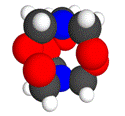Department of Chemistry
Date of this Version
April 2001
Abstract
Cross-polarization magic-angle spinning solid-state NMR spectroscopy has been used to investigate the dependence of 13C sugar chemical shifts on specific conformational parameters of a variety of ribonucleotides and ribonucleosides. Solid-state NMR is a valuable tool for nucleoside and nucleotide structural studies since it provides the means to acquire spectra that correspond to single conformations, as opposed to 13C solutionNMRmethods. The distinct effects of sugar puckering on the C1′, C4′, and C5′ resonances of C2′ endo (S type) and C3′ endo (N type) furanoid conformations allow us to separate them into two groups. Further analysis of each group reveals an additional dependence of the C1′ and C5′ resonances on the glycosidic and C4′– C5′ exocyclic torsion angles, respectively. However, it is found that the glycosidic conformation cannot independently be determined from sugar 13C chemical shift data. The statistical methods of exploratory data analysis and discriminant analysis are used to construct two canonical coordinates—linear combinations of chemical shifts which give the statistically optimal determination of the conformation from the NMR data.


Comments
Published in Journal of Magnetic Resonance 150 (2001), pp. 1–9. Available online at http://www.idealibrary.com Copyright © 2001 by Academic Press. Used by permission.